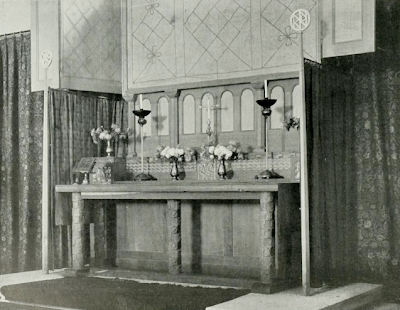 |
| Luther Hooper wool hanging from Hand-loom weaving, plain & ornamental, Pitman & Sons, London, 1920 |
Hooper describes the making of this in detail “on a ground of fine cream-coloured, mercerised cotton. The ground is a treble-thread tabby, but shows very little on the face of the web – only, in fact, in the bold outlines of the conventional lily and large leaf forms compose the trellis of the design. The lily is in scarlet wool, and is only tied down by a satin, which is made on the simple cords of the figure harness. This loose tie allows it to stand well above the general surface of the cloth. The green vase and foliage, and the dark blue background, are tied by a four-handle, single-thread twill, made by the binder harness. It is often found more convenient to weave this kind of material face upwards as the present example was made.” (Hooper,
St. Christopher's architect, Charles Spooner, describes another Luther Hooper piece at the church "the altar curtains are of red silk damask with copper-coloured silk lining, designed by Mr. Luther Hooper" (Nicholson, C., and Spooner, C., Recent Eccelesiastical Architecture, Technical Journals Ltd., London, c.1910).
 |
| St. Christopher's Church altar curtains by Luther Hooper, from Nicholson, C., and Spooner, C., Recent Eccelesiastical Architecture, Technical Journals Ltd., London |
Luther Hooper was based at Greenbushes, on the corner of Foundry Meadow and Foundry Lane. This 'Handicrafts of Haslemere' leaflet annotated by Godfrey Blount shows that Hooper was working in Haslemere from 1901-1908. Hooper was not recorded in the census in 1901 as being at Greenbushes, instead Maude Egerton King and Ethel Blount's sister, Marion Hine, was living there. Perhaps this was before Luther Hooper moved in, and Marion moved further up the hill to Silverbirches on Longdene where she was on the 1911 census. Luther Hooper perhaps moved a few hundred metres further down the road to the site of the present day St George's Flats, or maybe he operated from both venues. This is indicated by Blount in my earlier post, the Country Church was opened in "the weaving shops vacated by Luther Hooper (in 1908)".
I wonder what has happened to the church's Luther Hooper pieces, and where they are today? The Victoria & Albert Museum have numerous examples of his work, but unfortunately they have no images of them.

Beautifully produced piece of woven fabric. Thanks very much for this.
ReplyDeleteMy pleasure. It's a shame we don't know where this piece now is.
ReplyDeleteA real pedantic niggle. I do not think we can assume Charles Spooner wrote the article on (his own) St Christopher's church in 'Recent English Ecclesiastical Architecture'. He and Charles Nicholson were each commissioned to write a preface to the book (1911), but I am pretty sure the rest of the book's text, and the selection of the churches and photographs was by its editor, Mervyn Macartney.
ReplyDeleteThank you for the correction Alec. I'll need to amend my citation.
ReplyDelete